Beijing: Imperial Palace, Confucius Temple, Temple of Heaven, Summer Palace - Great Wall - Xian: Bell Tower, Giant Wild Goose Pagoda, Terracotta Army
Travel data
| Date of the journey | Juni 1999 |
| Duration | 10 days |
| Report online since | 25.11.2019 |
| Updated | 25.11.2019 |
As a German tourist you are fine. With no other pass you can visit so many countries visa-free. So you don't need a Hong Kong visa
for tourist stays of up to 90 days. Only for special cases, such as taking up work, requires a visa.
You have to apply for this in a similar way to the Chinese visa, but with the appropriate advice, this is usually not a problem.
 |
The Imperial Palace was formerly banned for ordinary citizens.
That's why it's even fuller today. Because it is the tourist attraction No. 1 in Beijing. Truly justified is also
the formerly common name "Forbidden City". And with the 1000 buildings it's actually a "city in the city". On the picture on the left,
therefore, only one of the buildings can be seen, the "Hall of Supreme Harmony", certainly one of the most splendid.
On the central axis are the representative buildings with such imaginative names as "Hall of Touch of Heaven and Earth",
"Palace of Collected Elegance" or "Hall of Care of the Heart". The servants lived in the side buildings.
In the back area finally you find the imperial living area. You can have an excellent view of the Imperial Palace from the coal hill,
which is directly connected to the north.
|
 |
Even today Confucius exerts a strong influence on the faith.
The philosopher lived in the 6th century BC and put the five basic virtues of humanity, lawfulness, custom, knowledge,
and credibility above all else. His motto was: No one should do something to another person that he does not want
to suffer for himself. Unfortunately, this is not always followed today. The Confucius Temple was built almost 2,000 years later,
in 1306. Noteworthy are the 198 stelae, on which the names of a total of 51 624 successful candidates were immortalized,
who served here before their civil service career.
|
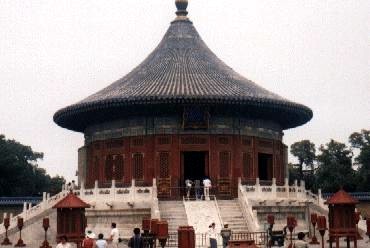 |
A popular destination of the population of Beijing is the Temple of Heaven.
In China as the "Middle Kingdom", the concept of the "center" plays an essential role. Here are all important values,
especially happiness. And how could you better bring out the center than the circular shape ?! In the Temple of Heaven,
therefore, all buildings are circular. This applies to the "palace of abstinence" as well as to the "hall of the harvest victim".
The highlight is the altar of heaven, which contains a very interesting numeral symbolism through its base plates and naturally
also emphasizes its center. Here, the Chinese are very happy to take pictures, you even have to queue regularly before you get
to the photo's turn. Around the Temple of Heaven is the beautifully landscaped Tiantan Park. Here you can go for a walk,
in the amusement park and in the beer garden and enjoy the whole day. Western tourists meet here almost never.
|
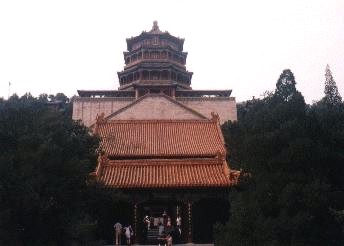 |
The Summer Palace: Even in winter it is full here.
Located northwest of Beijing, like the Imperial Palace, it was forbidden to ordinary citizens. In the huge artificial lake area,
more than 700m of covered walkway, numerous gardens, private theater, and the "pagoda of the fragrance and the Buddha,"
usually only members of the royal family and the servants were present. Until the 20th century The dowager Emperor Cixi
had a pleasant life here. Today the summer palace is a tourist attraction. In addition to the interesting buildings and gardens,
boat trips on the lake are also popular. However, this is not the sumptuous marble boat. At best, one could take the tea here.
|
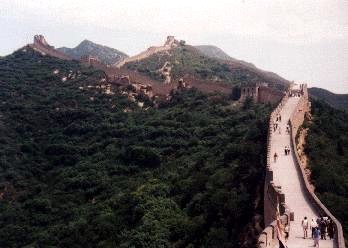 |
Like a lindworm, the Great Wall stretches thousands of kilometers through the landscape.
Certainly this is the most famous Chinese monument. And, according to astronauts, the only structure that can be seen
with the naked eye from the moon. How long it really is or has been, is controversial. It starts from up to 6300 km.
Its story can be traced back to well before Christ's birth. Individual parts existed even before the unification
of the Chinese Empire. Only Qin Shihuangdi, the first emperor, had the existing pieces combined to form a building.
Today, many parts have fallen apart. Especially well restored is the section of Badaling, 90 km north of Beijing.
|
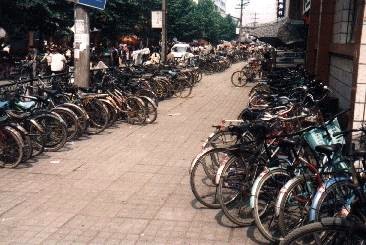 |
Neatly parked: In China, there are more bicycles than cars.
Those who own a car in China are certainly among the "top ten thousand". The means of locomotion of the people is the bicycle.
For example, Beijing has 11 million people and 8 million bicycles. Every major road has a bicycle lane that is usually wider
than the car lane. And that is necessary.
|
 |
To whom the bell tolls: The bell tower in Xian.
With almost 7 million inhabitants, the city is one of the larger ones, even in China. The city center is still
completely surrounded by a city wall. In all directions there are city gates, which are connected
by the straight main axes. At the intersection and thus in the center of the city stands the bell tower.
This building from 1582 proclaimed time for centuries, what else? Today there is an exhibition here,
of course the bell can still be seen. And you have a pretty good view along the streets to the city gates.
Nearby is the Drum Tower, and behind it begins the Islamic (!) Old Town. Here you can buy excellent (and cheap) souvenirs,
do not forget to trade! Especially worth seeing is the mosque, which is difficult to recognize as such.
Because it is built entirely in the style of a Chinese temple.
|
 |
The name comes from an old legend, geese are certainly not found here. There is a temple worth seeing
that surrounds the pagoda. The pagoda itself dates from the beginning of the 8th century,
but has been restored several times. You may even go up, but typically Chinese: You have to pay for this again.
But you will be rewarded with an excellent view. About 2 km closer to the city center, there is a second,
the small wild goose pagoda. This is not so well preserved, in particular, the associated temple doesn't exist any more.
|
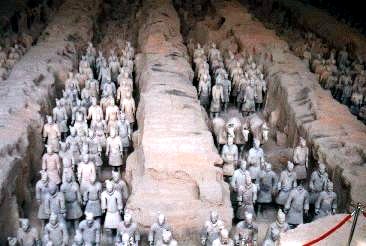 |
The first emperor of China did not want to be lonely even in death.
He had a whole army of life-size terracotta soldiers built. This as megalomaniacally classified endeavor sometimes
worked up to 700,000 forced laborers at this monumental grave. Only accidentally discovered in 1974,
the whole extent of the tombs is far from fully disclosed. The soldiers are made of terracotta,
a special material that exists here and in the surrounding area. The number of figures found so far is 6000,
maybe there are many more. Most impressive is Hall 1, where most of the terracotta soldiers can be seen.
In Hall 2, for example, one can still see the now petrified wooden roofs that were erected above the soldiers.
And Hall 3 is tiny compared to the other two.
|

